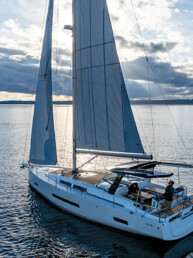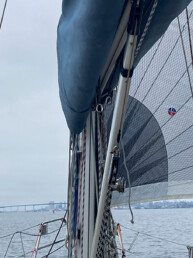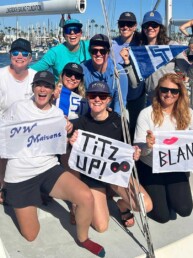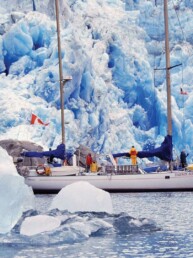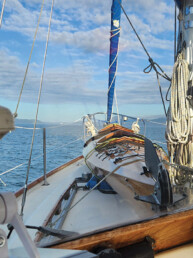This article originally appeared in the May 2021 issue of 48° North.
I’ll admit it, when I heard that Race to Alaska (R2AK) was being canceled for the second year in a row, I was a bit bummed. While I understood and supported the reasoning and know there’s nothing that can be done about a border closure, the news left me a bit dispirited. No, I wasn’t planning on participating like I had in 2018, but I was eager to settle in as an arm-chair-sailing tracker junkie and follow those who were.
Fortunately, that disappointed piece of my sailor psyche was buoyed with excitement when I heard rumblings that something new was in the works. Soon after, I was elated to learn that the team who dreamt up the madness that is R2AK wasn’t going to simply take another year off. Oh no, not possible. Instead, the “Adventure in Place” WA360 was born.
Or, as R2AK, SEVENTY48 and now WA360 Race Boss Daniel Evans put it, “The pearl that I consider WA360 to be was indeed pressured into creation by the vacuum of doom that repeated R2AK cancellations left in my heart. It was like a void that needed flooding and I wasn’t the only one who felt it.”
Indeed, Daniel was not the only person missing R2AK. After reading the race rules — which, like R2AK, are intentionally light on logistics — I started pouring over charts and contemplating the Port Townsend to Olympia to Point Roberts to Port Townsend course. While doing so, I couldn’t help but think, “I have to do this race. How could I not throw my hat in the WA360 ring?”
Soon after, a fellow crew member from 2018’s Team Wild Card messaged and asked, “Andy, WA360 on Wild Card?” Yep, I was in.
My initial reactions were obvious when taking a cursory look at the race track. Similar to R2AK, there are decisions to be made all over the course that are going to make or break some teams’ races. Also, whether they are strictly human powered or are capturing the wind, teams will need to be equal parts good and lucky when it comes to the transitions of wind to no wind and flood to ebb currents. With all that in mind, and more, here’s me throwing darts at a chart trying to anticipate what teams are likely to face, and what tracker junkies can look for in the inaugural WA360.
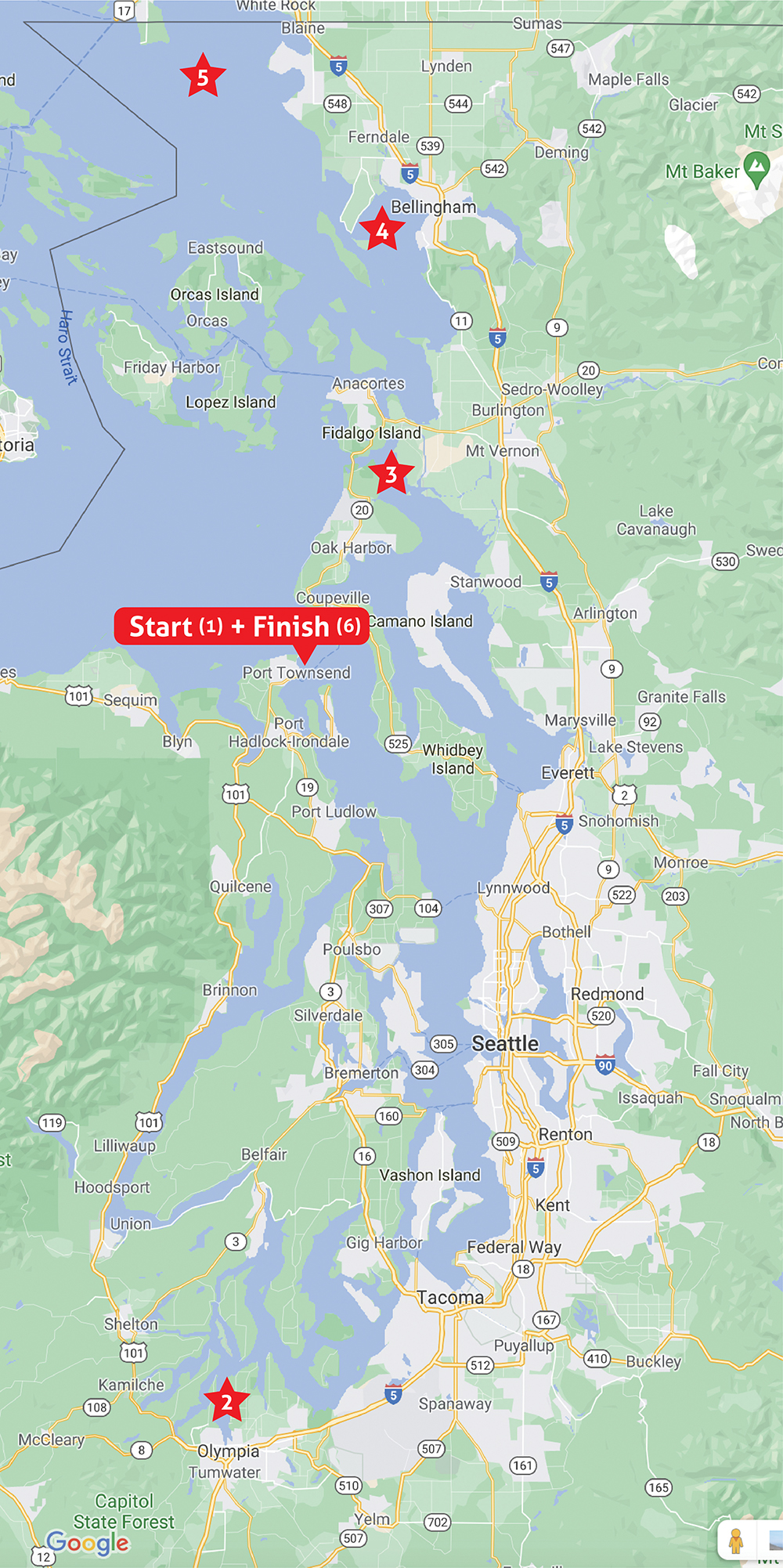 THE START
THE START
When the gun goes off at 6 a.m. on June 7 in Port Townsend Bay to signal the start of the inaugural WA360, what I and most prudent navigators will be focused on is the state of the tide and therefore, current. Low tide in the bay is at 9:21 a.m., which means the ebb will be decreasing after teams get off the line and begin working their way south. The next factor, of course, is wind. Prevailing winds this time of year are often light and variable in the morning, but if they’re up, it’s likely they’ll be from the north and sailors will get a spinnaker run.
Just after the start is where we’ll probably see the first split in the race. Boats that choose the Port Townsend Canal route and can fit under the bridge (VERT CL 58FT), will save some distance. Those that don’t, or can’t, will have to contend with Marrowstone Point and an outgoing tide which could potentially mean short-tacking the shoreline until your fear of running aground matches that of the scurrying crabs just below your keel.
DASH TO VASHON
Once teams have made it south of Marrowstone Island, the flood will turn on and central Puget Sound will be a 32-mile playground until the north end of Vashon Island. The positive current will help, but shipping lanes will need to be factored in as teams choose what side of the sound has the best wind for sailing or flattest, fastest water for pedaling or rowing. Take a good look at Seattle, racers. Give a hearty wave, it might be some time until you pass it again.
TACOMA NARROWS
At the top of Vashon, the logical next chess move is to head south down Colvos Passage working the beaches to mitigate the everpresent northerly flowing current. Going around the east side of Vashon and Maury islands could see a potential split in the action, but it’s about 5 miles farther and will depend on what the wind and current are doing when teams get there.
From the northern end of Vashon through Colvos, it’s roughly 16 miles to the Tacoma Narrows Bridge. The Narrows is going to be a tidal gate that racers and tracker junkies will be keeping an eye on. What teams make it through first? Who gets stopped? The ebb current begins around 5:15 p.m. on the 7th, and even the fastest of boats won’t be punching through until it turns in the wee hours of the morning. If teams have made good progress on day one, they can squeak through on the early morning flood, which has a max current of 2.7 knots at 2:00 a.m. on June 8th. If they miss that first flood of the day, it could mean dropping anchor in Gig Harbor to wait, grab a bite to eat, and get some shuteye. We shall see.
ROUND SOUTH SOUND
After breaking free of the Narrows, South Puget Sound will present challenges in wind, current, and routing while working towards Olympia Shoal (route requirement number two) and back again. Notorious for lack of breeze this time of year, I’ve cruised the South Sound in June a few times and have been pleasantly surprised with good sailing — so, it is possible.
For sailors and human-powered racers alike, there’s going to be no magic potion to solving the South Sound riddle. Playing connect-the-puffs will be key for sailing teams, and staying in positive current and out of adverse current will be the ticket for everyone. That fact is no mystery, but it will make it either fun or frustrating for those watching the tracker to see if their horse is gaining or fading. It’s likely to be a bit of both and my guess is that we’ll see some strategic anchoring moves to not lose too much ground.
NORTH TO WHIDBEY
With the U-turn complete in Budd Inlet, it’s approximately 95-miles to the next mandatory waypoint of passing within one nautical mile of Goat Island in Skagit Bay (route requirement number three). For those scoring at home, that 95 miles includes a backtrack out of the South Sound, past the Narrows, up the Central Sound and then into some new territory inside Whidbey Island. I fully expect this section of the race to put some teams far ahead or behind with a couple great equalizers yet to come.
THE BIG DECISION
When teams reach Goat Island they’ll have thought about the decision they need to make here well in advance and will likely have lost some sleep over it. I know I will. That decision? Go through notoriously devious Deception Pass and out into Rosario Strait, or (OR!), tackle the narrow, current laden Swinomish Channel which dumps you out into Padilla Bay. Hmm… the plot thickens.
The goal here is to make it around “Bellingham outfall buoy Fl Y 10s priv” (route requirement number four) in Bellingham Bay. Taking the Swinomish route will be about 4 miles shorter, but it could be an arduous slog up the slough. Alternatively, if teams can negotiate Deception Pass in good time, getting out into the Strait could bring better breeze. Either way, this moment has the potential to be the widest splitting point on the entire course.
U-TURN TWO
With Bellingham Bay over their shoulders, rounding “Point Roberts Buoy R ‘4’” (route requirement number five) is a fairly straightforward section of the race course. Once clear of Lummi Island, there are no geographic obstacles to getting there, but wind and current will decide if it’s a rhumb line course, a series of tacks or jibes, or the need to find relief on the beach. All the while, teams will be looking ahead at the weather and tides to make a call on what to do when the U-turn has been made.
THE CHOICE IS YOURS
From Point Roberts Buoy R “4” to Point Wilson and then the finish is slightly over 50 miles as the crow flies. Alas, these racers aren’t taking flight, and standing right smack in their way is the entire San Juan Archipelago and then the Strait of Juan de Fuca. If the Deception–Swinomish decision is the biggest on the course, this could prove to be a close second.
Conventional wisdom to the navigator (navi-guesser?) would be to just head south down Rosario Strait, leave Smith Island to starboard while crossing the Strait of Juan de Fuca and then into the finish. Boom done.
But, if one were looking to throw a hail mary in the final seconds of the contest and the current and wind were in your favor, a dash to the west down San Juan Channel and out of Cattle Pass could put a team in an advantageous position coming out into the strait. If this option works, teams might be setup for a possible spinnaker run or jib-reach towards Point Wilson if the common thermal westerly fills in. It might be a long shot, but that final crossing and a glorious photo finish on the Northwest Maritime Center dock in Port Townsend would be epic. Decisions, decisions.
THE FINALE
With a month to go until the starting gun fires, it’s anybody’s guess as to what will transpire in this inaugural 360-mile lap around Washington waters and who rings the bell in each class. Some will race it in all-out fashion to try to win the championship belt and bragging rights. Others will take it as a personal challenge against themselves and nature. To be sure, every racer will walk away with a story to tell. And if nothing else, it’ll be one helluva adventure in place.
THE RULES
Similar to R2AKs of years past, the start of the WA360 is on June 7, 2021 in Port Townsend and the rules are deliberately simple. Here they are:
- Unlike R2AK, you can keep your engine aboard, but if you use it, you’re out.
- Like the R2AK, human powering is legit.
- First boat to finish for each class wins.
- Two weeks. That’s how long teams have to call themselves a finisher.
- If the support isn’t preplanned, and generally available to any and all racers, it’s okay.
- Stopping along the way is totally fine, just avoid towns and stay COVID real.
CLASSES & PRIZES
After reading the rules, the one thing that stands out is, “…each class wins.” Having classes is a notable change from R2AK, and Race Boss Daniel Evans summed up the decision this way: “It was hard to make the choice of establishing classes, because it feels like a compromise of my values, but these races tend to tell their own story and the values are those shared by all racers.”
Here’s the class breakdown:
- Go Fast: The fastest of the fast, racing sleds and catamarans with a sail to cupholder ratio that exceeds 1:1.
- Go Hard: Others might call this “Cruising Class.”
We’re not those people. Racing a cruiser is inherently slower, which is harder. - Human Powered: Kayaks, rowboats, SUPs, and other muscle-laden heroes who, for whatever reason, forgo the wind.
According to WA360 HQ, whatever class you chose is up to you: “If you’re a paddle boarder and you want to go up against the big sleds…fine. If you’re a TP52 with a navigation system from NASA with a flux capacitor core and try to enter as a paddleboard in the human-powered class? We’re not gonna buy it. We don’t know PHRF, but we’re badass at poker. Play it straight and earn a story you’re proud to tell.
If you come in first in your racing class, you’ll forever have your team engraved on a big ass championship belt. Think 10 pounds of leather and shiny metal held high with both hands and a Zoom-room throng of people chanting your name.”
THE COURSE
Monday morning the 7th will come quickly for racers and their vessels will have been vetted and ready to tackle 360-miles of North, Central and South Puget Sound mayhem.
Completing these six route requirements will ensure WA360 success:
- Start just off the Northwest Maritime Center dock at 6 a.m.
- ROUND Olympia Shoal in Budd Inlet
- PASS WITHIN 1 NM of Goat Island in Skagit Bay
- ROUND Bellingham outfall buoy Fl Y 10s priv
- ROUND Point Roberts Buoy R “4” 4s BELL
- Finish by landing on the dock at the Northwest Maritime Center
For more information and to follow the race, visit www.nwmaritime.org/wa360
Andy Cross
Andy Cross is the editor of 48° North. After years cruising the Pacific Northwest and Alaska with his family aboard their Grand Soleil 39, Yahtzee, they sailed south and are currently in the Caribbean Sea. You can follow their adventures at SailingYahtzee.com.

